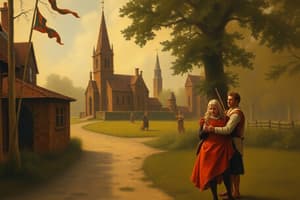Podcast
Questions and Answers
What is a key feature of the Medieval Period?
What is a key feature of the Medieval Period?
- Decline in urbanization
- Technological regression
- Rapid industrialization
- Significant population growth (correct)
Which of the following cities experienced significant growth during the Medieval Period?
Which of the following cities experienced significant growth during the Medieval Period?
- Madrid
- Paris (correct)
- Berlin
- Moscow
What economic system was prominent in much of Europe during the Middle Ages?
What economic system was prominent in much of Europe during the Middle Ages?
- Capitalism
- Feudalism (correct)
- Communism
- Socialism
Who worked the lands granted by nobles in the feudal system?
Who worked the lands granted by nobles in the feudal system?
Which of these factors did NOT influence the transformations during the Medieval Period?
Which of these factors did NOT influence the transformations during the Medieval Period?
What was a significant force shaping both the church and broader society during the Middle Ages?
What was a significant force shaping both the church and broader society during the Middle Ages?
What were cathedrals primarily built as during the Medieval Period?
What were cathedrals primarily built as during the Medieval Period?
Which of the following was a significant feature of the Medieval Period related to the Christian faith?
Which of the following was a significant feature of the Medieval Period related to the Christian faith?
What impact did religion have on daily life during the Medieval Period?
What impact did religion have on daily life during the Medieval Period?
Which sector experienced significant growth in trade activities during the Medieval Period?
Which sector experienced significant growth in trade activities during the Medieval Period?
What technological advancement allowed mariners to navigate more accurately during the Medieval Period?
What technological advancement allowed mariners to navigate more accurately during the Medieval Period?
Where did the concept of zero in mathematics originate before spreading to Western Europe?
Where did the concept of zero in mathematics originate before spreading to Western Europe?
Flashcards are hidden until you start studying
Study Notes
Medieval History Overview
The Middle Ages, commonly known as the Medieval Period or simply as the Middle Ages, was a time of significant change in world history. This period spanned from around AD 500 to approximately AD 1500. It is often divided into three main sections: Early, High, and Late Medieval periods. During this time, societies underwent profound transformations influenced by factors such as population growth, technological advancements, and cultural shifts.
Population Growth And Urbanization
One key development during the Medieval Period was the rise in population across Europe. This led to increased urbanization, with people moving to cities to take advantage of economic opportunities, better living conditions, and social networks. Cities like Paris, London, Rome, Florence, and Venice grew significantly during this time. These developments had important implications for political structures, religious institutions, trade, and culture.
Feudalism
The feudal system emerged in various areas of Europe between the late ninth and early eleventh centuries. In this system, nobles granted lands to knights in exchange for military service and loyalty. Serfs, who were mainly small farmers, worked these lands and paid taxes to their lords. Feudalism played a crucial role in shaping European society and politics throughout much of the Middle Ages.
Religion And Society
Medieval Christianity was a powerful force shaping both the church and broader society. Monasteries became centers of learning and art production, while cathedrals were built as symbols of power and devotion. Crusades were also a prominent feature of the era, with Christian armies embarking on campaigns to regain control over Jerusalem and other holy sites. However, religion wasn't just about faith and spirituality; it also impacted daily life through practices like tithes and penance.
Trade And Commerce
During the Medieval Period, trading activities expanded beyond local markets towards international exchanges, including luxury goods, spices, and silk. Long distance trade routes developed along rivers, overland paths, and sea routes, connecting regions as far apart as China and Northern Africa. This expansion fostered new technologies and manufacturing techniques, which contributed to rising levels of trade activity.
Science And Technology Advances
Advances in metallurgy, agriculture, textile production, and shipbuilding occurred during the Medieval Period. For example, the invention of the compass allowed mariners to navigate more accurately, contributing to the Age of Discovery later on. Additionally, the concept of zero in mathematics, which originated in India, spread throughout the Islamic world via Arab mathematicians before reaching Western Europe.
In summary, the Medieval Period saw a combination of societal changes, technological advances, and intellectual pursuits that shaped the course of human history. From growing populations and shifting economic patterns to the emergence of key ideas and institutions, this epoch laid the groundwork for future eras of discovery and progress.
Studying That Suits You
Use AI to generate personalized quizzes and flashcards to suit your learning preferences.




